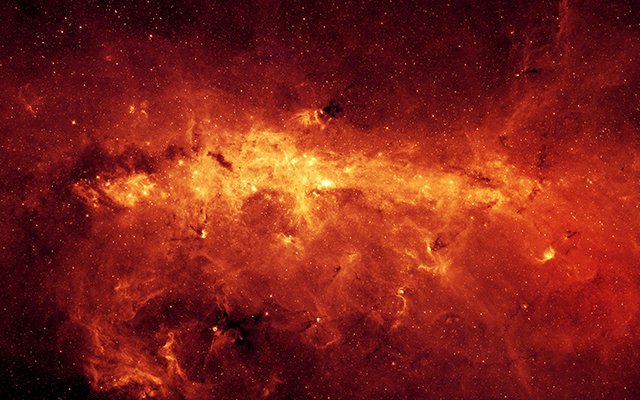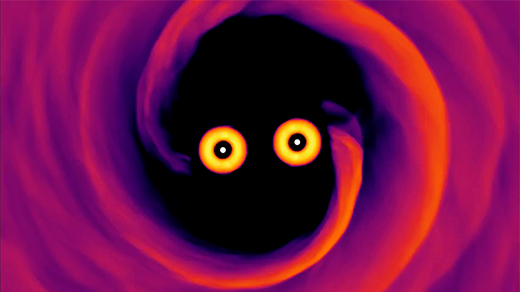Dwarf Galaxies Dim Hopes of Dark Matter

Once again, a shadow of a signal that scientists hoped would amplify into conclusive evidence of dark matter has instead flatlined, repeating a maddening refrain in the search for the invisible, omnipresent particles.
The Fermi Large Area Telescope (LAT) failed to detect the glow of gamma rays emitted by annihilating dark matter in miniature “dwarf” galaxies that orbit the Milky Way, scientists reported Friday at a meeting in Nagoya, Japan. The hint of such a glow showed up in a Fermi analysis last year, but the statistical bump disappeared as more data accumulated.
“We were obviously somewhat disappointed not to see a signal,” said Matthew Wood, a postdoctoral researcher at Stanford University who was centrally involved in the Fermi-LAT collaboration’s new analysis, in an email.
Scientists homed in on the dwarf galaxies after Dan Hooper, a theoretical astrophysicist at the Fermi National Accelerator Laboratory in Batavia, Ill., and Lisa Goodenough, his graduate student at the time, detected an unexplained gamma-ray signal coming from the center of the Milky Way in 2009. Hooper and several collaborators proposed that the gamma rays might be due to dark matter in the form of WIMPs, or weakly interacting massive particles, which are the leading candidates for the invisible substance that comprises six-sevenths of the universe’s mass. When two WIMPs collide in the dense galactic center, they should annihilate, with gamma rays as the fallout. Over the past five years the intriguing gamma-ray signal has seemed more and more likely to be the detritus of annihilating WIMPs.
However, scientists knew that the same glow could also originate from an unknown population of millisecond pulsars in the galactic center — bright, rapidly spinning stars that spew gamma rays into space.
Looking for ways to distinguish the two possibilities, scientists turned to dwarf galaxies, which are thought to be rich in dark matter but free of pulsars. If researchers found gamma rays pouring out of dwarf galaxies, the observation would rule out alternative explanations and provide emphatic evidence of WIMPs.
Yet no such signal has been detected in five years’ worth of the highest-quality data from 15 nearby dwarfs, Wood and his colleagues report. “Dwarf galaxies are one of the few targets which could give us a definitive confirmation of a signal in the galactic center,” Wood said. “Without this confirmation the case for the dark matter interpretation of the galactic center excess is substantially weakened.”
The possibility remains that the signal from the Milky Way’s center does come from dark matter, but only if the density of dark matter in the galaxy is at the high end of researchers’ estimates. If dark matter is sufficiently dense, it doesn’t have to annihilate at a very high rate to explain the signal from the galactic center. And if dark matter annihilates at a low rate, then researchers shouldn’t be surprised when they don’t see a signal coming from the more-diffuse dwarfs.
“At this stage we do not entirely exclude all of the dark-matter models proposed to explain the reported excess,” Wood said.
Hooper, whose model barely survives the blow of the new dwarf-galaxy findings, seems unfazed, and he maintains his position that the signal from the galactic center most likely comes from colliding WIMPs that vanish in puffs of gamma rays. “That’s where my money is,” he told Quanta Magazine in March. Speaking from the meeting in Japan, he said, “That hasn’t changed in any significant way.”
Other scientists agree that the dark-matter explanation of the gamma-ray excess is still viable, for now. “It is what it is,” said Savvas Koushiappas, a physicist at Brown University and co-author of another recent analysis of gamma rays from the dwarfs. “There is a dark-matter interpretation, and the dwarfs at the moment did not rule it out, or confirm it. However, we are close.”
Tracy Slatyer, a physicist at the Massachusetts Institute of Technology who has collaborated with Hooper on models of the galactic-center excess, said she finds the new results “really encouraging.”
“Of course, I would like the galactic-center excess to come from annihilating dark matter, but I would much rather know one way or the other,” she said. “This result increases the probability that we will know for sure in the near future.”
The paradigm that dark matter is likely composed of WIMPs has long reigned among physicists because of the “WIMP miracle,” or the fact that the same hypothetical particle could account for mysteries of both the cosmic and the quantum worlds. With roughly the same mass as many of the known particles in nature, WIMPs would counteract the effects of those particles in quantum equations in a way that would make apparently faulty calculations work. And the presence of a halo of WIMPs around galaxies would explain why the galaxies rotate faster than expected at their outskirts — the most compelling indirect evidence that dark matter exists.
But the fact that WIMPs would represent an elegant solution to deep questions doesn’t mean they’re real. Scientists have spent the past decade monitoring ultra-cooled vats of liquid chemicals located deep underground in repurposed mine shafts all over the world, hoping that WIMPs would occasionally leave traces of energy as they traversed the liquids. But the search has not produced a single convincing signal.
As the experiments become ever more sensitive, they eat away at the abstract space of all viable WIMP models, giving it the look of Swiss cheese. The discouraging results have pushed researchers to get more creative. “Even though many people are working very hard on the WIMP paradigm, people are starting to think more broadly,” said Mark Trodden, a professor of theoretical physics at the University of Pennsylvania.
Dwarf galaxies have already inspired alternatives to the standard WIMP picture. If dark-matter particles can interact with one another (instead of “weakly interacting” only with ordinary matter, as in conventional WIMP models), they will transfer heat as they collide. “When you transfer heat, you get a less dense center,” explained David Spergel, an astrophysicist at Princeton University who, along with his colleague Paul Steinhardt, first proposed the self-interacting dark-matter scenario in 2000. Indeed, astronomers have observed that the cores of dwarf galaxies are less dense than would be expected based on simulations of galaxy formation that use WIMPs.
Self-interacting dark matter has attracted growing interest among scientists, but not everyone feels comfortable postulating a new property to patch over the problems with current models.
“We’re just making this invisible particle increasingly complicated,” said Justin Khoury, a theoretical physicist at the University of Pennsylvania. “I’m torn about that.”
Meanwhile, new and improved simulations by Alyson Brooks of Rutgers University and colleagues suggest that dwarf galaxies can be modeled correctly without dark matter self-interactions after all, if the simulations include the effects of ordinary particles — the one-seventh of all matter that we actually see, but which models often ignore for the sake of simplicity. When stars go supernova, Brooks explained, they produce hot bubbles of gas that rapidly expand. “It turns out that process gives energy to the dark matter in the center of galaxies and pushes it out,” she said.
Although Brooks’ simulations match observations, some other leading modelers can’t get the effects of ordinary matter to fix the discrepancy in their own simulations, fueling the interest in self-interacting dark matter.
Complicating the debate is the fact that if dark-matter particles self-interact, that means they don’t annihilate upon contact in bursts of gamma rays. In that case, the signal from the Milky Way’s center would not come from dark matter.
“If this all sounds lively and contradictory and confused, you have the right idea,” Steinhardt said.
Khoury has moved the furthest from the WIMP picture with a recent paper postulating that dark matter may not be composed of particles at all. His theory revamps an old idea called modified Newtonian dynamics, or MOND, which proposes a change to the law of gravity. In Khoury’s theory, dark matter is a fluidlike field that permeates space, interacting with the gravitational fields of galaxies in a way that alters their rotation.
Erik Verlinde, a theoretical physicist at the University of Amsterdam in the Netherlands, has proposed a different modified-gravity theory, one in which dark matter doesn’t exist at all and the rotational speeds of galaxies reflect the entropy, or disorder, of space and time.
At this stage, one theorist’s guess seems as good as another’s.
“There are many, many, many things that dark matter could be,” Trodden said. “If you gave me license to write down particle physics [models] that could give me dark matter, I could write down 10 that haven’t been thought about before.” As for which ones hold the most promise, the universe isn’t telling.
Correction: This article was revised on October 26, 2014, to present Matthew Wood’s full quote about the status of the dark-matter interpretation of the galactic-center gamma ray excess. The original shortened quote did not accurately convey Wood’s intended meaning.
This article was reprinted on NationalGeographic.com.



